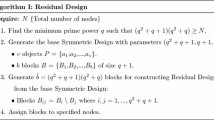Abstract
With the advent of modern communications systems, much attention has been put on developing methods for securely transferring information between constituents of wireless sensor networks. To this effect, we introduce a mathematical programming formulation for the key management problem, which broadly serves as a mechanism for encrypting communications. In particular, an integer programming model of the q-Composite scheme is proposed and utilized to distribute keys among nodes of a network whose topology is known. Numerical experiments demonstrating the effectiveness of the proposed model are conducted using using a well-known optimization solver package. An illustrative example depicting an optimal encryption for a small-scale network is also presented.







Similar content being viewed by others
Notes
Note that Gurobi may produce a nonzero optimality gap even if the incumbent solution is optimal. In such cases, additional time is required to validate that the incumbent solution is optimal.
References
Blom, R.: An Optimal Class of Symmetric Key Generation Systems, pp. 335–338. Springer, Berlin (1985). https://doi.org/10.1007/3-540-39757-4_22
Blundo, C., De Santis, A., Herzberg, A., Kutten, S., Vaccaro, U., Yung, M.: Perfectly-Secure Key Distribution for Dynamic Conferences, pp. 471–486. Springer, Berlin (1993). https://doi.org/10.1007/3-540-48071-4_33
Campos-Naez, E., Garcia, A., Li, C.: A game-theoretic approach to efficient power management in sensor networks. Oper. Res. 56(3), 552–561 (2008). https://doi.org/10.1287/opre.1070.0435
Camtepe, S.A., Yener, B.: Combinatorial design of key distribution mechanisms for wireless sensor networks. IEEE/ACM Trans. Netw. 15(2), 346–358 (2007). https://doi.org/10.1109/TNET.2007.892879
Carvalho, M., Sorokin, A., Boginski, V., Balasundaram, B.: Topology design for on-demand dual-path routing in wireless networks. Optim. Lett. 7(4), 695–707 (2013). https://doi.org/10.1007/s11590-012-0453-0
Chen, C.Y., Chao, H.C.: A survey of key distribution in wireless sensor networks. Secur. Commun. Netw. 7(12), 2495–2508 (2014). https://doi.org/10.1002/sec.354
Didla, S., Ault, A., Bagchi, S.: Optimizing AES for embedded devices and wireless sensor networks. In: Proceedings of the 4th International Conference on Testbeds and Research Infrastructures for the Development of Networks and Communities, TridentCom’08, pp. 4:1–4:10. ICST (Institute for Computer Sciences, Social-Informatics and Telecommunications Engineering), ICST, Brussels, Belgium (2008)
Eschenauer, L., Gligor, V.D.: A key-management scheme for distributed sensor networks. In: Proceedings of the 9th ACM Conference on Computer and Communications Security, CCS’02, pp. 41–47. ACM, New York (2002). https://doi.org/10.1145/586110.586117
He, T., Vicaire, P., Yan, T., Cao, Q., Zhou, G., Gu, L., Luo, L., Stoleru, R., Stankovi, J.A., Abdelzaher, T.: Achieving real-time target tracking using wireless sensor networks. In: Technical Report (2006)
Kim, S., Pakzad, S., Culler, D., Demmel, J., Fenves, G., Glaser, S., Turon, M.: Health monitoring of civil infrastructures using wireless sensor networks. pp. 254–263 (2007). https://doi.org/10.1145/1236360.1236395
Li, X., Aneja, Y.P.: A branch-and-cut approach for the minimum-energy broadcasting problem in wireless networks. INFORMS J. Comput. 24(3), 443–456 (2012). https://doi.org/10.1287/ijoc.1110.0463
Liu, D., Ning, P.: Establishing pairwise keys in distributed sensor networks. In: Proceedings of the 10th ACM Conference on Computer and Communications Security, CCS’03, pp. 52–61. ACM, New York (2003). https://doi.org/10.1145/948109.948119
Rossi, A., Singh, A., Sevaux, M.: Column generation algorithm for sensor coverage scheduling under bandwidth constraints. Networks 60(3), 141–154 (2012). https://doi.org/10.1002/net.20466
Rossi, A., Singh, A., Sevaux, M.: An exact approach for maximizing the lifetime of sensor networks with adjustable sensing ranges. Comput. Oper. Res. 39(12), 3166–3176 (2012). https://doi.org/10.1016/j.cor.2012.04.001
Rossi, A., Singh, A., Sevaux, M.: Lifetime maximization in wireless directional sensor network. Eur. J. Oper. Res. 231(1), 229–241 (2013). https://doi.org/10.1016/j.ejor.2013.05.033
Ruj, S., Nayak, A., Stojmenovic, I.: Pairwise and triple key distribution in wireless sensor networks with applications. IEEE Trans. Comput. 62(11), 2224–2237 (2013). https://doi.org/10.1109/TC.2012.138
Shin, I., Shen, Y., Thai, M.T.: On approximation of dominating tree in wireless sensor networks. Optim. Lett. 4(3), 393–403 (2010). https://doi.org/10.1007/s11590-010-0175-0
Simplício Jr., M.A., Barreto, P.S.L.M., Margi, C.B., Carvalho, T.C.M.B.: A survey on key management mechanisms for distributed wireless sensor networks. Comput. Netw. 54(15), 2591–2612 (2010). https://doi.org/10.1016/j.comnet.2010.04.010
Waltenegus, D., Poellabauer, C.: Fundamentals of Wireless Sensor Networks: Theory and Practice—Waltenegus Dargie, Christian Poellabauer. Wiley, Hoboken (2010)
Werner-Allen, G., Lorincz, K., Ruiz, M., Marcillo, O., Johnson, J., Lees, J., Welsh, M.: Deploying a wireless sensor network on an active volcano. IEEE Internet Comput. 10(2), 18–25 (2006). https://doi.org/10.1109/MIC.2006.26
Wu, W., Gao, X., Pardalos, P.M., Du, D.Z.: Wireless networking, dominating and packing. Optim. Lett. 4(3), 347–358 (2010). https://doi.org/10.1007/s11590-009-0151-8
Author information
Authors and Affiliations
Corresponding author
Additional information
Publisher's Note
Springer Nature remains neutral with regard to jurisdictional claims in published maps and institutional affiliations.
Rights and permissions
About this article
Cite this article
Xu, G., Semenov, A. & Rysz, M. An integer programming formulation of the key management problem in wireless sensor networks. Optim Lett 14, 1037–1051 (2020). https://doi.org/10.1007/s11590-019-01465-2
Received:
Accepted:
Published:
Issue Date:
DOI: https://doi.org/10.1007/s11590-019-01465-2




